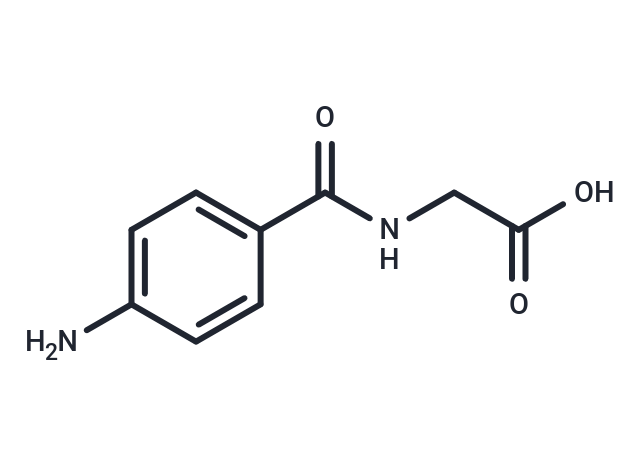Shopping Cart
- Remove All
 Your shopping cart is currently empty
Your shopping cart is currently empty

4-Aminohippuric Acid is the glycine amide of 4-aminobenzoic acid. Its sodium salt is used as a diagnostic aid to measure effective renal plasma flow (ERPF) and excretory capacity.

| Pack Size | Price | Availability | Quantity |
|---|---|---|---|
| 50 mg | $35 | In Stock | |
| 100 mg | $47 | In Stock | |
| 200 mg | $68 | In Stock | |
| 1 mL x 10 mM (in DMSO) | $50 | In Stock |
| Description | 4-Aminohippuric Acid is the glycine amide of 4-aminobenzoic acid. Its sodium salt is used as a diagnostic aid to measure effective renal plasma flow (ERPF) and excretory capacity. |
| In vitro | In normal individuals, the renal extraction ratio of 4-Aminohippuric acid is approximately 0.92. After extraction, the majority of 4-Aminohippuric acid is actively secreted by the proximal tubules and completely excreted by the kidneys. The clearance of 4-Aminohippuric acid is utilized to measure renal plasma flow and to assess the secretory mechanisms or transport limits of renal tubules. The kinetics of 4-Aminohippuric acid uptake by cortical tubular cells have been measured using the stopped-flow microperfusion technique in rat kidneys. In a rat model of renal failure, intravenous injection of 3.0 mg/kg Uranyl nitrate significantly reduced the CLPAH to 0.89 mL/min/kg, compared to 29.30 mL/min/kg in normal rats. Rats with chronic kidney failure exhibited altered pharmacokinetics, showing decreased renal excretion of 4-Aminohippuric acid. Compared to Sham rats, those with chronic kidney failure demonstrated a weakened load of excretion, filtration, and secretion of 4-Aminohippuric acid, with about a 40% reduction in the expression of OAT1 in the homogenate and membrane. Hence, measuring the renal clearance of 4-Aminohippuric acid typically reflects the kidney's capacity for organic anion transport. |
| In vivo | At a concentration of 10 mmol/L, 4-Aminohippuric acid was transported across membranes of HEK293 cells expressing MRP2 with a rate of 21.9 pmol/mg protein/min. The kinetic parameters for 4-Aminohippuric acid transport included a Km value of 880 mM and a Vmax value of 2.3 nmol/mg protein/min, indicating facilitated transport through organic anion transporters expressed in epithelial cells. Additionally, 4-Aminohippuric acid uptake by HEK293 cells, mediated by overexpressed and transfected NPT1, exhibited saturable kinetics in line with Michaelis-Menten dynamics, having a Km close to 2.66 mM and a Vmax of 940 pmol/mg protein/30s. This compound is also transported by transporters other than OAT, including NPT1 and MRP2. |
| Alias | p-Aminohippuric acid |
| Molecular Weight | 194.19 |
| Formula | C9H10N2O3 |
| Cas No. | 61-78-9 |
| Smiles | NC1=CC=C(C=C1)C(=O)NCC(O)=O |
| Relative Density. | 1.356 g/cm3 |
| Storage | Powder: -20°C for 3 years | In solvent: -80°C for 1 year | Shipping with blue ice. | ||||||||||||||||||||
| Solubility Information | DMSO: 50 mg/mL (257.48 mM), Sonication is recommended. Ethanol: 2 mg/mL (10.3 mM), Sonication is recommended. H2O: 3 mg/mL (15.45 mM), Sonication is recommended. | ||||||||||||||||||||
Solution Preparation Table | |||||||||||||||||||||
Ethanol/H2O/DMSO
| |||||||||||||||||||||

Copyright © 2015-2025 TargetMol Chemicals Inc. All Rights Reserved.